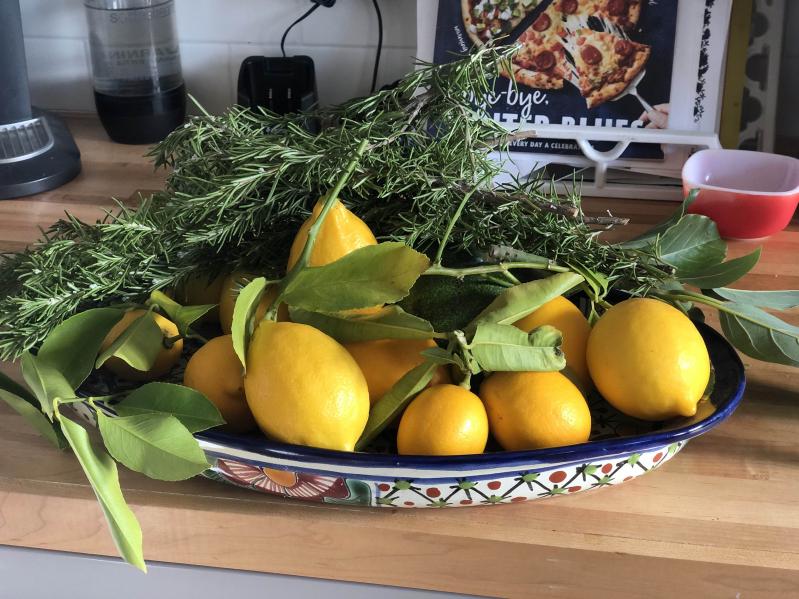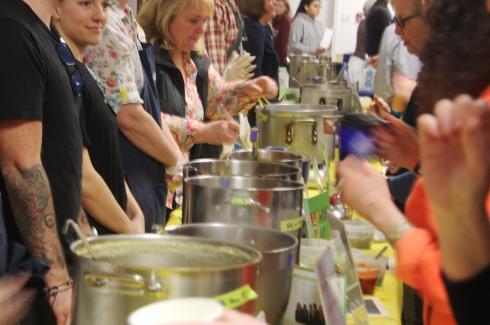At this time of year, when tomatoes and many other fruits or vegetables are lemons, turn to lemons to refresh a tired menu.
The price of lemons (usually about 10 cents each) fluctuates very little during the year, although lemons are basically a winter crop. California orchards yield fruit which is cut from the branches before it is quite ripe “curing,” to acquire the typically yellow color. Growers claim that this method produces better lemons. Incidentally, they also store better. Unlike oranges, lemons are spared the rigors of bleaching and dying.
The Maximum Juice
Lemon experts (excluding Ralph Nader) give various suggestions for extracting the maximum juice. Some say to heat the lemon first. Or try rolling an uncut lemon back and forth on a counter-top while pressing down on it. One dealer recommends waiting until the skin starts to shrivel before using. Once you have cut a lemon, place a piece of cheese cloth or nylon net over the cut side to obtain seedless juice. One whole lemon should yield three to four tablespoons of juice and about one tablespoon of grated peel.
The high acid content of a lemon makes it useful in keeping certain fruits and vegetables from discoloring once cut. Sprinkle apples, peaches, pears, and bananas with lemon juice. Rub a lemon on your hands to remove evidence of garlic or food stains.
There are few foods with which a spiking of lemon flavor is incompatible. Lemon will, of course, enhance fish and seafood, both hot and cold (cut the lemon into wedges, not those skinny slices which are attractive but impossible to squeeze).
A Garnish
Lemon will garnish soups as well as flavor them. Use lemon in sauces, from hollandaise to mayonnaise, in butter, mustard, salad dressing, marinades (try lemon juice mixed with mustard and a little melted butter or olive oil for shrimp or artichokes).
Leg of lamb, harboring a multitude of garlic slivers in its flesh, can be basted with lemon juice. Serve broiled lamb chops or chicken with lemon wedges and add a final squirt to veal or chicken sautes. Lemon can flavor pilafs and potatoes but lemon juice will dull the color of green vegetables so lemon butter is better.
Lemon pies, mousses or souffles are delightful in winter and can be garnished with fresh berries in summer. Remember this palindrome: no lemon? No melon!
In Everything
The Greeks use lemon in everything. An inspired combination of eggs and lemon juice (“avgolemono”) transforms the simplest dishes. For avgolemono soup, start with good, clear chicken broth with rice. The egg and lemon mixture (two eggs beaten with the juice of one lemon are the usual proportions) is heated by the addition of some of the hot soup and then slowly returned to the kettle while the cook stirs constantly. From that point on heating must be very gentle or the eggs will curdle and you might consider a Cantonese menu instead.
Avgolemono is also used in sauces for meat and poultry, as in the following chicken dish. The lemon squares are tangy, rich, and quickly assembled.
Chicken With Broccoli
1 roasting chicken (about 4 lbs.)
1 bunch broccoli
3 Tbsp. olive oil
1 cup chopped onion
1 clove garlic, minced
1 cup dry white wine
salt and pepper
1 bay leaf
2 eggs
Juice of 1 lemon (about 1/4 cup)
Preheat oven to 350 degrees. Dry chicken. Cut and separate broccoli flowerets from stems and reserve. Peel and chop stems. Heat oil in an Stir in flour, baking soda, lemon oven-proof casserole large enough to hold the chicken whole. Lightly brown chicken in oil. Remove chicken from casserole.
Lower heat, add onion and chopped broccoli stems and saute several minutes, until onion is transparent but not browned. Add garlic and saute another minute or two. Stir in wine, scraping bottom of casserole. Return chicken, along with any juices which may have seeped out of it, to casserole, season with salt and pepper, place bay leaf on top of chicken and cover chicken with a piece of buttered foil.
Cover casserole and bring to a simmer on top of the stove. Place casserole in preheated oven and roast for 30 minutes. Place broccoli flowerets in casserole around chicken, cover again and continue to roast about 20 minutes longer, until broccoli is just tender and chicken is done. Remove chicken and disjoint or carve onto a heated serving platter. Arrange broccoli flowerets around chicken, cover platter with foil and keep warm.
Return casserole to top of stove. Season sauce carefully with salt and pepper and bring to a gentle simmer. Beat eggs with lemon juice. Stir in some of the heated sauce. Slowly dribble egg mixture back into the casserole, stirring constantly. Heat until somewhat thickened but DO NOT BOIL. Pour sauce over chicken and broccoli and serve at once. Serves four to six.
Note: A rice pilaf is a perfect accompaniment. For a one-dish meal, spread prepared pilaf on serving platter and arrange chicken and broccoli on top of it, then add sauce.
Lemon Honey Squares
1/2 cup butter, at room temperature
1/2 cup confectioner’s sugar
1 cup flour
2 eggs
2/3 cup granulated sugar
1/3 cup honey
2 Tbsp. flour
1/3 tsp. baking soda
4 Tbsp. lemon juice
3 Tbsp. grated lemon rind
Confectioner’s sugar
Preheat oven to 350 degrees. Butter and flour a nine-inch square baking pan. Cream butter and confectioner’s sugar together. Cut in flour to form a soft dough. Press dough into bottom of baking pan (use a lightly floured spoon or hands).
Bake for 20 minutes. Meanwhile, beat eggs with sugar and honey. Stir in flour, baking soda, lemon juice and rind. Spread on pastry. Bake for another 20-25 minutes. Cool completely. Cut into squares and dust with powdered sugar. Makes 16 two-inch squares.





